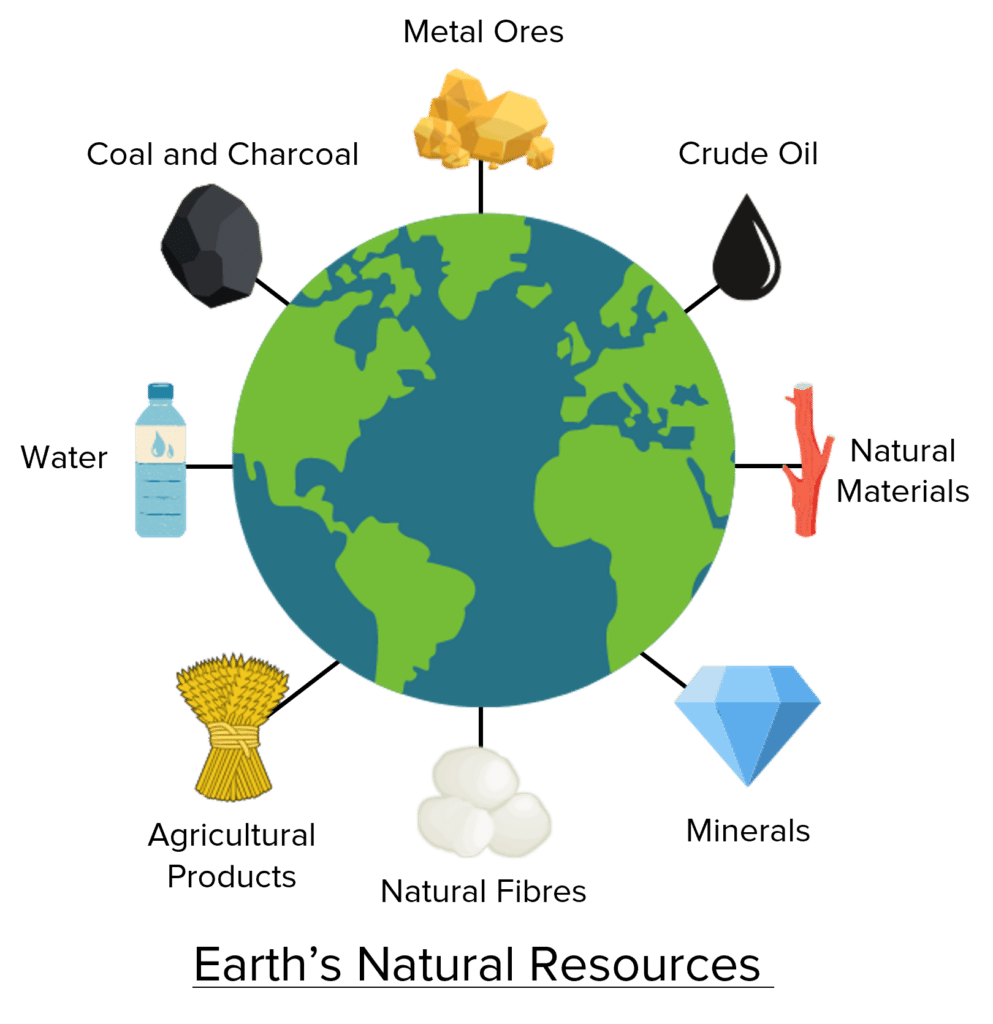Earth's Natural Resources
Earth's Natural Resources Revision
Earth’s Natural Resources
The Earth provides many of resources that are used in everyday society. These natural resources can be renewable or non-renewable. The non-renewable nature of many resources means that humanity must try to use them in sustainable ways.
Using the Earth’s Resources

The Earth holds a whole host of resources that are useful to humanity. These resources are produced without the need for any human influence and instead grow or form naturally.
Because these resources exist without the need for human influence, they are known as natural resources. Natural resources come in a range of different forms, from hard minerals through to liquid water and can all be extracted from the earth, the atmosphere, or the oceans. Examples of natural resources include coal and crude oil, metal ores, agricultural crops, and natural building materials such as wood.
In the modern world, many of natural resources have however been replaced using synthetic ones. For example, for most of human history clothing has been produced using natural fibers like cotton or wool. Today, more than half of the fibers used in textile manufacture are synthetic (e.g. nylon or polyester).
Other natural resources, particularly agricultural ones, are often improved for modern uses. Natural crops are increasingly being improved using techniques such as genetic modification. These techniques can be used to make crops more resistant to diseases or to increase their nutritional content.
Metals are another example of natural resources that are improved by human effort. Metals are often combined with other elements, both metal and non-metal, to manipulate their properties. For example, iron is mixed with small amount of carbon to produce steel. This increases the strength of the metal, making it an ideal material for use in construction.
It is important to remember that, though may of the resources we used today may be synthetic or improved, these new resources must still be produced from sources that are natural.
Renewable and Non-Renewable Resources
Natural resources can be broadly split into two categories, renewable and non-renewable.
Renewable resources are ones that can be reformed over a relatively short period of time. These resources are often organic ones (i.e. ones that can be grown), such as agricultural resources or natural materials like wood, cotton, or wool. Once used, these resources can be regrown to replenish them. This means that renewable resources can be reproduced in the time it takes for them to be used. This means that, used responsibly, we will not run out of these resources.
Lots of resources are not renewable however. Many resources such as metal ores, coal, and crude oil are all non-renewable meaning that the the time taken for these materials to be reformed is far too long for the resource to be replenished for human use. For example, crude oil is a natural resource that is formed over tens of millions of years. Once it is used, it would take tens of millions more years to be reproduced. As a result, crude oil will be used much faster than it can be replaced, meaning it will eventually be completely used up. It is for this reason that non-renewable resources are also referred to as finite resources.
Using Resources Sustainably
The finite nature of many of the Earth’s resources means that it is important for humanity to use them sustainably. Sustainable use of resources means that we use those resources in a way that meets our current needs without jeopardizing the ability of future generations to meet theirs. For example, fossil fuels are finite resources that we use to meet our energy needs. To use them sustainably, we must be sure that we do not deplete them. If society in the present day were to burn through all the worlds fuel reserves, this would prevent future generations from being able to meet their own energy needs.
Any resource that can be depleted should be conserved as much as is possible to ensure that future generations will not be deprived of them. There are a number of ways to ensure that our use of resources is sustainable.
One method is to recycle what materials we can so that we do not use more than is necessary. By recycling resources we can make them last longer. Another is to reduce the use of a resource in the first place. We can do this cutting down on waste and unnecessary usage. We can also replace non-renewable resources with alternative resources that are renewable (such as solar and wind in the case of fossil fuels) and that will not be depleted.
Earth's Natural Resources Example Questions
Question 1: Define the term non-renewable.
[1 mark]
A resource that is used faster than it is able to form.
Question 2: State two example of a natural resource.
[2 marks]
Any two from:
- Crude oil
- Metal Ores
- Precious Gems
- Agricultural Products
- Water
- Minerals
- Natural Fibers
(Allow suitable alternatives.)
Question 3: Explain what is meant by the term “sustainable use of resources.”
[3 marks]
- The use of a resource to meet current needs.
- Without jeopardising the ability of future generations to meet theirs.





